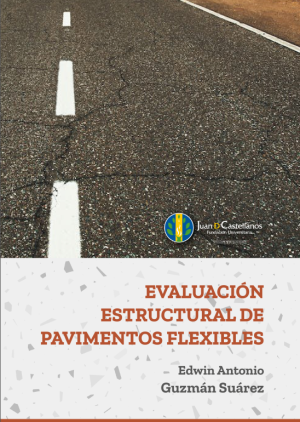Evaluación estructural de pavimentos flexibles
Sinopsis
Descargas
Citas
AASHTO. (1993). Guía para el diseño de estructuras de pavimento. American Association of State Highway and Transportation Ofcials.
Al-Khateeb, G., Shenoy, A., Gibson, N. y Harman, T. (2006). A new simplistic model for dynamic modulus predictions of asphalt paving mixtures. Journal of the AAPT, 75E, 1-40. https://www.researchgate.net/publication/301676481_A_new_simplistic_model_for_dynamic_modulus_predictions_of_asphalt_paving_mixtures
Alderete, N. y Brizuela, L. (2014). Diseño de pavimentos urbanos por retrocalculo según guía AASHTO 93 mediante la utilización del deflectómetro liviano de impacto. Infraestructura Vial, 16(27), 4-14. https://revistas.ucr.ac.cr/index.php/vial/article/view/14554/13819
Alshibli, K. A., Abu-Farsakh, M. y Seyman, E. (2005). Laboratory evaluation of the geogauge and light falling weight deflectometer as construction control tools. Journal of Materials in Civil Engineering, 17(5), 560-569. https://doi.org/10.1061/(asce)0899-1561(2005)17:5(560)
Anochie-Boateng, J., Tutumluer, E., Apeagyei, A. y Ochieng, G. (2015). Resilient behavior characterization of geomaterials for pavement design. http://hdl.handle.net/10204/4412.
Austroads. (2019a). Guide to pavement technology part 2 Pavement estructural design. https://austroads.com.au/publications/pavement/agpt02/media/AGPT02-17_Guide_to_Pavement_Technology_Part_2_Pavement_Structural_Design.pdf
Austroads. (2019b). Guide to pavement technology part 5 Pavement evaluation and treatment design. https://austroads.com.au/publications/pavement/agpt05/media/AGPT05-19_Guide-toPavement-Technology-Part-5-Pavement-Evaluation.pdf
Ávila, T., Rodríguez, E., Barrantes, R., Castro, J., Allen, J., Arriola, R. y Sequeira, W. (2016). Manual de auscultación visual de pavimentos de Costa Rica. https://www.lanamme.ucr.ac.cr/repositorio/handle/50625112500/850
Baladi, G., Dawson, T. y Sessions, C. (2009).Pavement subgrade MR design values for Michigan's seasonal changes. https://www.michigan.gov/documents/mdot/MDOT_Research_Report_RC1531_291954_7.pdf
Bryce, J., Flintsch, G., Samer, P., Katicha, W., Brian, K. y Diefenderfer, P. (2013). Developing a Network-Level Structural Capacity Index for Structural Evaluation of Pavements. https://doi.org/10.1061/(ASCE)TE.1943-5436.0000494
Cámara Chilena de la Construcción. (1996). Uso de los resultados del eflectómetro de impacto en el método de diseño AASHTO 1993. https://extension.cchc.cl/datafles/8536-2.pdf
Careaga, J. (1997). Evaluación del comportamiento de pavimentos y criterios para su conservación y rehabilitación.
Carneiro, B. (1966). Benkelman beam, auxiliary instrument of the maintenance engineer. Transportation Research Record, 129, 28-59. https://onlinepubs.trb.org/Onlinepubs/hrr/1966/129/129-003.pdf
Chatti, K., Ji, Y., Harichandran, R. y Hyung, S. L. (2004). Development of a computer program for dynamic backcalculation of flexible pavement layer moduli. Final report, Research Project RC-1450. Michigan Department of Transportation.
Chen, D., Bilyeu, J., Lin, H. y Murphy, M. (2000). Temperature correction on falling weight deflectometer measurements. Transportation Research Record, 1716, 30-39. https://doi.org/10.3141/1716-04
Christopher, B., Schwartz, C., Boudreaux, R. y Berg, R. (2006). Geotechnical aspects of pavements. Federal Highway Administration, FHWA NHI-05-037,888. https://www.fwa.dot.gov/engineering/geotech/pubs/05037/05037.pdf
Corros, M., Urbaéz, E. y Corredor, G. (2009). Manual de evaluación de pavimentos. http://www.mediafre.com/download/l8zg7owu65tkm7g/Manual_de_Evaluación_de_Pavimentos.pdf
Crook, A., Montgomery, S. y Guthrie, W. (2012). Using falling-weight deflectometer data for network-level 2 flexible pavement management. Transportation Research Record, 2304 (1), 75-85 . https://doi.org/10.3141/2304-09
Crovetti, J. (2005). Development of rational overlay design procedures for flexible pavements. https://minds.wisconsin.edu/bitstream/handle/1793/53879/WHRP_05-12_Rational_Overlay_Design.pdf?sequence=1&isAllowed=y
Del Aguila, P. (2007). Determinación del módulo resiliente del suelo de fundación mediante método mecanístico - empiricista (método Hogg simplifcado). [Ponencia] XIV Congreso Ibero Latinoamericano Del Asfalto.
Elseif, M., Abdel-khalek, A. y Dasari, K. (2012). Implementation of rolling wheel deflectometer ( RWD ) in PMS and pavement preservation. No. FHWA/11.492. https://rosap.ntl.bts.gov/view/dot/24897
European Cooperation in Science and Technology. (1998). COST 336 - FWD at network level. https://cordis.europa.eu/docs/publications/3182/31828341-6_en.pdf
Fernando, E. y Ho, J. (2011). Comparison of resilient modulus values used in pavement design. BDL76-1. https://trid.trb.org/view/1097330
FHWA. (2017). Using Falling Weight Deflectometer Data with Mechanistic-Empirical Design and Analysis, Volume I: Final Report. Report No. FHWA-HRT-16-009. Federal Highway Administration.
Garnica, P., Pérez, A., Garcia, R. y Cruz, S. (1993). Influencia de la temperatura en la determinación de la capacidad estructural de pavimentos flexibles.
Giovanon, O., Pagola, M. y Naranjo, T. (2000). Corrección por temperatura de las deflexiones lacroix. http://congresodevialidad.org.ar/congreso2016/TRA/TRA-070.pdf.
Goktepe, A., Agar, E. y Lav, A. (2006). Advances in backcalculating the mechanical properties of flexible pavements. Advances in Engineering Sofware, 37(7), 421-431. https://doi.org/10.1016/j.advengsof.2005.10.001
Gómez, O. (2015). Criterios de optimización del diseño de sobrecarpetas asfálticas para Bogotá, basados en ensayos no destructivos [tesis de maestría, Universidad Nacional de Colombia]. Repositorio institucional UNAL. https://repositorio.unal.edu.co/handle/unal/53880
Gopalakrishnan, K. (2009). Backcalculation of Non-Linear Pavement Moduli Using Finite-Element Based Neuro-Genetic Hybrid Optimization. Te Open Civil Engineering Journal, 3(1), 83-92. https://doi.org/10.2174/1874149500903010083
Gopalakrishnan, K., Kim, S. y Ceylan, H. (2010). Non-destructive evaluation of in-place rehabilitated concrete pavements. Journal of Civil Engineering and Management, 16(4), 552-560. https://doi.org/10.3846/jcem.2010.61
Guzmán-Suárez, E. (2017). Factores para el ajuste de los módulos de retrocálculo de pavimentos flexibles. Ciencia, Innovación y Tecnología, 3, 73-89. https://doi.org/10.38017/2390058X.76
Hall, K., Darter, M. y Elliott, R. (1992). Revision of AASHTO pavement overlay design procedures. http://onlinepubs.trb.org/Onlinepubs/trr/1992/1374/1374-005.pdf
Higuera, C. (2010). Caracterización de la resistencia de la subrasante con la información del deflectómetro de impacto. Revista Facultad de Ingeniería, 19(28), 73-92. https://doi.org/10.19053/01211129.1398
Hoffman, M. (2003). A direct method for evaluating the structural needs of flexible pavements based on FWD deflections. Transport Reasearch Record 1860, 41-47. https://doi.org/10.3141/1860-05
Hoffman, M., Berger, L. y Del Aguila, P. (1985). Estudios de evaluacion estructural de pavimentos basados en la interpretacion de curvas de deflexiones (ensayos no destructivos). https://d1wqtxts1xzle7.cloudfront.net/53323585/cam039.pdf?1496110133=&response-content-disposition=inline%3B+filename%3DESTUDIOS_DE_EVALUACION_ESTRUCTURAL_DE_PA.pdf&Expires=1638812670&Signature=ZM2nxHZj0fFn9wUcpXFBNvh639jWPZViOHNFFknoJHlsV3ypDECxGQ3HlUfQJ
Hoffmann, M. (1982). Comparative study of selected nondestructive testing devices. Transportation Research Record, 852, 32-41. https://onlinepubs.trb.org/Onlinepubs/trr/1982/852/852-005.pdf https://doi.org/10.1212/WNL.32.8.852
Horak, E., Stephen, E. y Maina, J. (2015). Review of falling weight deflectometer deflection benchmark analysis on roads and airfelds. 11th Conference on Asphalt Pavements for SouthernAfrica: CAPSA15, 16-19.
Horak, E. (2008). Benchmarking the structural condition of flexible pavements with deflection bowl parameters. Journal of the South African Institution of Civil Engineering, 50(2), 2-9. http://www.scielo.org.za/pdf/jsaice/v50n2/01.pdf
Horak, E. (1987). Aspects of deflection basin parameters used in a mechanistic rehabilitation design procedure for flexible pavements in South Africa. [tesis doctoral, Universidad de Pretoria]. Repositorio institucional UP. https://repository.up.ac.za/bitstream/handle/2263/23960/Complete.pdf?5
Horak, E., Maina, J. y Hefer, A. (2014). Structural number determined with the falling weight deflectometer and used as benchmark methodology. 2014 International Conference on Civil Engineering, Energy and Environment Structural, December, 26-36.
Hossam, S., El-Raof, R., El-Hakim, S. y Affy, & H. A. (2018). Structural number prediction for flexible pavements using the long term pavement performance data. International Journal of Pavement ngineering, 21(7), 841-855. https://doi.org/10.1080/10298436.2018.1511786
HTC Infrastructure Management Ltd. (2000). Implementation of predictive modelling for road management - establishing pavement strength for use with dTIMS.
Huang, Y. (2004). Pavement analysis and design (2.a ed.). Pearson Prentice - Hall. http://docshare04.docshare.tips/fles/14013/140138713.pdf
Huichapillan, H. E. (2006). Controles receptivos en carreteras de asfalto, inversión y ahorro público privado. Universidad Austral de Chile.
Instituto Nacional de Vías-INVÍAS. (2006). Estudio e investigación del estado actual de las obras de la red nacional de carreteras. Manual para la inspección visual de pavimentos flexibles. http://www.invias.gov.co/index.php/historico-cartelera-virtual/doc_download/974-manual-para-la-inspeccion-visual-de-pavimentos-flexibles
Instituto Nacional de Vías-INVÍAS. (2008). Guía metodológica para el diseño de obras de rehabilitación de pavimentos asfálticos para carreteras.
Instituto Nacional de Vías-INVÍAS. (2013). SECCIONES 700 Y 800-Materiales y mezclas asfálticas y prospección de pavimentos (Primera parte). Especifcaciones INVÍAS.
Instituto Nacional de Vías-INVÍAS. (2015). Manual de diseño de pavimentos asfálticos en vías con medios y altos volúmenes de tránsito. INVÍAS.
Kamath, D. (1987). Analysis of flexible pavement on the basis of deflection basins [tesis de maestría, Universidad Central de Florida]. https://stars.library.ucf.edu/cgi/viewcontent.cgi?article=6066&context=rtd
Kim, Y., Ranjithan, S., Troxler, J. y Xu, B. (2000). Assessing pavement layer condition using deflection data.
Kim, Y., Hibbs, B. y Lee, Y. (1995). Temperature correction of deflections and backcalculated asphalt concrete moduli. Transportation Research Record, 1473, 55-62. http://onlinepubs.trb.org/Onlinepubs/trr/1995/1473/1473-007.pdf
Koch, C., Zhu, Z., Paal, S. y Brilakis, I. (2013). Machine vision techniques for condition assessment of civil infrastructure. Integrated Imaging and Vision Techniques for Industrial Inspection: Advances and Applications, 1-536. https://doi.org/10.1007/978-1-4471-6741-9
Kurt, D., Bruinsma, J., Monty, J., Chatti, K., Vandenbossche, J. y Yu, H. (2017). Using falling weight deflectometer data with mechanisticempirical design and analysis, volume I (No. FHWA-HRT-16-009). United States. Federal Highway Administration.
Labuz, J., Dai, S., Skok, E. y Lukanen, E. (2008). Pavement rehabilitation selection. Minnesota Department of Transportation. http://www.lrrb.org/media/reports/200806.pdf
Lay, M. G. (2009). Handbook of Road Technology. In Gordon and Breach Science Publishers SA (4th ed.). Taylor & Francis e-Library. https://doi.org/10.1201/9781482288667
Limited, T. & T. (1998). Pavement deflection measurement & interpretation for the design of rehabilitation treatments. Research Report, 117, 1-42.
Lopes, F. M. (2012). Pavimentos flexíveis com revestimento asfáltico-avaliação estrutural a partir dos parâmetros de curvatura da bacia de deformação. Universidade Estadual De Campinas.
López, L. y Mendoza, A. (1998). Evaluación estructural no destructiva de pavimentos (J. E. Jiménez, ed.). https://www.imt.mx/archivos/Publicaciones/PublicacionTecnica/pt107.pdf
Ng, K., Hellrung, D., Ksaibati, K. y Wulff, S. (2018). Systematic back-calculation protocol and prediction of resilient modulus for MEPDG. International Journal of Pavement Engineering, 19(1), 62-74. https://doi.org/10.1080/10298436.2016.1162303
Nguyen, B. T. (2016). Resilient behaviour of fne-grained and granular materials for the design of flexible pavements [doctoral thesis, University RMIT]. https://researchbank.rmit.edu.au/view/rmit:161668
Norouzi, M. (2013).Performance evaluation of flexible pavements in alberta using falling weight deflectometer data [doctoral thesis, University of Alberta]. https://www.proquest.com/openview/ee5e45bc9dec8a16240b144af042e009/1?pq-origsite=gscholar&cbl=18750
Noureldin, S., Zhu, K., Harris, D. y Li, S. (2005). Non-Destructive estimation of pavement thickness, structural number and subgrade resilience along INDOT highways. Transportation Research Program, 109. https://docs.lib.purdue.edu/cgi/viewcontent.cgi?article=1629&context=jtrp https://doi.org/10.5703/1288284313281
Orozco, R. (2005). Evaluacion de pavimentos flexibles con metodos no destructivos. Universidad Nacional Autónoma de México.
Osorio, A. (2008). Metodología de evaluación in-situ de la capacidad de soporte de bases y subbases granulares de pavimentos flexibles con el deflectómetro de impacto liviano [tesis de maestría, Pontifcia Universidad Católica de Chile]. Repositorio institucional UC. https://repositorio.uc.cl/handle/11534/1435
Park, D., Buch, N. y Chatti, K. (2001). Effective layer temperature prediction model and temperature correction via falling weight deflectometer deflections. Transportation Research Board, 1764(1), 97-111. https://doi.org/doi:10.3141/1764-11
Pierce, L., Bruinsma, J., Smith, K., Wade, M., Chatti, K. y Vandenbossche, J. (2017). Using falling weight deflectometer data with mechanisticempirical design and analysis, volume III: guidelines for deflection testing, analysis, and interpretation. Report No. FHWA-HRT-16-011. Federal Highway Administration, III. https://doi.org/10.1520/STP104445
PITRA. (2018). Parámetros de análisis estructural de pavimentos en Costa. https://www.lanamme.ucr.ac.cr/repositorio/handle/50625112500/1588
Porta, S. Y. (2016). Evaluación y comparación de metodologias indice de condicion de pavimentos (PCI) y visión e inspección de zonas e itinerarios en riesgo (VIZIR) en la avenida mariscal castilla) tramo: fundo el porvenir-la victoria[tesis de pregrado, Universidad Nacional del Centro del Perú]. https://www.docsity.com/es/evaluacion-depavimentos-mediante-metodo-pci-y-vizir/2545894/
Priest, A. y Timm, D. (2006). Methodology and calibration of fatigue transfer functions for mechanistic empirical flexible pavement design. In National Center for Asphalt Technology Auburn University, Alabama (Issue December). http://trid.trb.org/view.aspx?id=850274
Quintus, H. y Killingsworth, B. (1997). Design Pamphlet for the backcalculation of Pavement Layer Moduli in support of the AASHTO Guide for the Design of Pavement Structures.
Reddy, M., Reddy, K, y Pandey, B. (2005). A rational approach for design of flexible overlays for Indian highways. In Indian Road Congress (Vol. 73, Issue January).
Richard, K. Y. y Park, H. (2002). Use of Falling Weight Deflectometer Multi-Load Data For Pavement Strength Estimation. Report No. FHWA/NC/2002-006, June, 1-191.
Roesset, J. M., Stokoe, K. H. y Seng, C. R. (1995). Determination of depth to bedrock from falling weight deflectometer test data. Transportation Research Record, 2(1504), 68-78. https://onlinepubs. trb.org/Onlinepubs/trr/1995/1504/1504-007.pdf
Rohde, G. T. (1994). Determining pavement structural number from FWD testing. Transportation Research Record, 1448, 61-68. http://onlinepubs.trb.org/Onlinepubs/trr/1994/1448/1448-008.pdf
Rohde, G. y Hartman, A. (s.f.). Comparison of procedures to determine structural number from FWD deflection. Combined 18th ARRB Transport Research Conference and Transit New Zealand Land Transport Symposium, 99-115. https://trid.trb.org/view/470309
Rondón, H. y Reyes, F. (2007). Metodologías de diseño de pavimentos flexibles: Tendencias, alcances y limitaciones. Ciencia e Ingeniería Neogranadina, 17(2), 41-65. https://doi.org/10.18359/rcin.1074
Rwebangira, T., Hicks, R. y Truebe, M. (1987). Sensitivity analysis of selected backcalculation procedures. Transportation Research Record, 6(1117), 25-37. http://onlinepubs.trb.org/Onlinepubs/trr/1987/1117/1117-004.pdf
Saleh, M. (2014). Simplifed approach for structural capacity evaluation of flexible pavements at the network level. International Journal of Pavement Engineering, 17(5), 440-448. https://doi.org/10.1080/10298436.2014.993202
Saleh, M. (2016a). A mechanistic empirical approach for the evaluation of the structural capacity and remaining service life of flexible pavements at the network level. Canadian Journal of Civil Engineering, 43(8), 749-758. https://doi.org/10.1139/cjce-2016-0060
Saleh, M. (2016b). Simplifed approach for structural capacity evalution of flexible pavements at the network level. International Journal of Pavement Engineering, 17(5), 440-448. https://doi.org/10.1080/10298436.2014.993202
Salt, G. y Stevens, D. (2001). Pavement performance prediction: determination and calibration of structural capacity (SNP). 20th ARRB Transport Research Conference, 15.
Sandoval, E. y Rivera, W. (2019). Correlación del CBR con la resistencia a la compresión inconfnada. Ciencia e Ingeniería Neogranadina, 29(1), 135-152. https://doi.org/10.18359/rcin.3478
Sargand, S., Vega, C. y Arboleda, L. (2013). Long term performance of existing asphalt concrete pavement sections. Revista Facultad de Ingenieria Universidad de Antioquia, 66, 45-56. http://tesis.udea.edu.co/bitstream/10495/5442/1/SargandShad_2013_LongTermPerformance.pdf
Schnoor, H. y Horak, E. (2012). Possible method of determining structural number for flexible pavements with the falling weight deflectometer. 31st Annual Southern African Transport Conference, July, 94-109. https://repository.up.ac.za/handle/2263/20033
Schwartz, C., Afsharikia, Z. y Khosravifar, S. (2017). Standardizing lightweight deflectometer modulus measurements for compaction quality assurance. No. MD-17-SHA-UM-3-20. Universidad de Maryland. https://rosap.ntl.bts.gov/view/dot/32862
Solatifar, N., Abbasghorbani, M., Kavussi, A. y Sivilevičius, H. (2018). Prediction of depth temperature of asphalt layers in hot climate areas. Journal of Civil Engineering and Management, 24(7), 516-525. https://doi.org/10.3846/jcem.2018.6162
Solminihac, H., Echaveguren, T. y Chamorro, A. (2019). Gestión de infraestructura vial (3.a ed.). ALFAOMEGA U.C. DE CHILE. https://doi.org/10.2307/j.ctvkjb4dw
South African National Roads Agency Ltda. (2013). Chapter 10: Pavement Design. In South African Pavement Engineering Manual: Vol. Chapter 10 (Issue January).
Stubstad, R., Jiang, Y. y Lukanen, E. (2006). Guidelines for review and evaluation of backcalculation results. February. http://trid.trb.org/view.aspx?id=782964
Sukumaran, B., Kyatham, V., Shah, A. y Sheth, D. (2002). Suitability of using California Bearing Ratio test to predict resilient modulus. FAA, Federal Aviation Administration Airport Technology Transfert Conference, 44(8), 1-10. https://doi.org/10.1088/1751-8113/44/8/085201
Tavira, J. (2009). Cálculo mecánico de pavimentos a partir de ensayos no destructivos. Universidad de Sevilla.
Timm, D., Turochy, R. y Davis, K. (2010). Guidance for ME pavement design implementation. No. ALDOT Project 930-685. http://www.eng.auburn.edu/users/timmdav/ALDOT_930-685.pdf
TM ARMY. (1994). Pavement design for roads, streets and open storage areas, Elastic Layered Method. https://www.wbdg.org/FFC/ARMYCOE/COETM/ARCHIVES/tm_5_822_13.pdf
TNM. (2007). Calibración de las curvas de deterioro de los pavimentos de Bogotá D.C. - Fase II versión 1.
Tonkin y Taylor Ltd. (1998). Pavement deflection measurement and interpretation for the design of rehabilitation treatments. https://www.nzta.govt.nz/assets/resources/research/reports/117/117-Pavement-deflection-measurement-and-interpretation-for-thedesign-of-rehabilitation-treatments.pdf
Urbaéz, E., Lockhart, J., Giovanon, O. y Schvartzer, F. (2004). Estimación del valor "C" incluido en el método AASHTO-93 para el retro-cálculo modular de la subrasante. III Congreso Venezolano Del Asfalto. Venezuela (4: 6 - 9, Octubre, 6, 3.
Vásquez, L. (2002). Pavement Condition Index (PCI) Para pavimentos asfálticos y de concreto en carreteras. Ingepav, 90.
Vaswani, N. (1971). A method for evaluating the structural performance of subgrades and/or the overlying flexible pavements. https://rosap.ntl.bts.gov/view/dot/19870
Von Quintus, H. y Killingsworth, B. (1997). Design pamphlet for the determination of layered elastic moduli for flexible pavement design in support of the 1993 AASHTO guide for the design of pavement structures. (No. FHWA-RD-97-077). United States. Federal Highway Administration. Ofce of Engineering Research and Development., 32.
Von Quintus, H. y Killingsworth, B. (1997). Design pamphlet for the determination of design subgrade in support of the 1993 AASHTO guide for the design of pavement structures. In No. FHWA-RD-97-083. https://rosap.ntl.bts.gov/view/dot/40877
Von Quintus, H. y Simpson, A. (2002). Back-calculation of layer parameters for LTPP test sections volume II : Layered elastic analysis for flexible and rigid pavements. In Report No. FHWA-RD-01-113. Federal Highway Administration: Vol. II. https://rosap.ntl.bts.gov/view/dot/40869
Washington State Department of Transportation. (1995). WSDOT pavement guide (Vol. 2, Issue Febrero, p. 780).
Washington State Department of Transportation. (2005). Everseries user's guide, pavement analysis computer sofware and cases studies. https://apps.itd.idaho.gov/apps/manuals/Materials/MaterialsReferences/EverseriesUG1-2.pdf
Xu, B., Ranjithan, S. y Kim, Y. (2002). New relationships between falling weight deflectometer deflections and asphalt pavement layer condition indicators. Transportation Research Record, 1806, 48-56. https://doi.org/10.3141/1806-06
Yao, B., Cheng, C., Wang, X., Cheng, G. y Song-Yu, L. (2013). Modeling the rheological properties of epoxy asphalt concrete. Journal of Harbin Institute of Technology, 20, 106-111. https://doi.org/10.1002/app.32440
Yousefdoost, S., Vuong, B., Rickards, I., Armstrong, P. y Sullivan, B. (2013). Evaluation of dynamic modulus predictive models for typical australian asphalt mixes. Proceedings of the 15th AAPA International Flexible Pavements Conference, 19, 1-18.
Zaghloul, S., Gucunski, N., Jackson, H. y Hadidi, R. (2006). Material characterization and seasonal variation in material properties. No. FHWA-NJ-2005-024.
Zhang, Z., Claros, G., Manuel, L. y Damnjanovic, I. (2003). Evaluation of the pavement structural condition at network level using falling weight deflectometer (FWD) data. 82nd Annual Meeting of the Transportation Research Board, 1-26.
Zhang, Z., Manuel, L., Damnjanovic, I. y Li, Z. (2003). Development of a new methodology for characterizing pavement structural condition for network level applications. Center for Transportation Research, Bureau of Engineering Research, the University of Texas at Austin. No. FHWA/TX-04/0-4322-1, 100. https://ctr.utexas.edu/wp-content/uploads/pubs/0_4322_1.pdf

Descargas
Publicado
Categorías
Licencia

Esta obra está bajo una licencia internacional Creative Commons Atribución-NoComercial-SinDerivadas 4.0.



